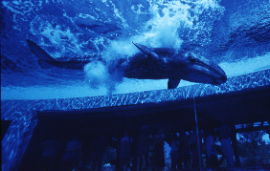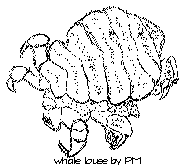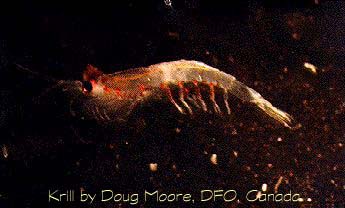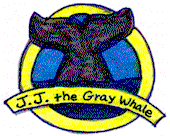|
|||||||||||||||||||
 |
|
| J.J. in her big tank |
![]() fter J.J. was brought to SeaWorld,
she was put in a small tank that was used for sick
animals. J.J. was small then. She was shedding skin a lot
and growing fast. Soon they had to move her to a bigger
tank. The tank was approximately 32 feet deep and was
filled with 1.7 million gallons of salt water.
fter J.J. was brought to SeaWorld,
she was put in a small tank that was used for sick
animals. J.J. was small then. She was shedding skin a lot
and growing fast. Soon they had to move her to a bigger
tank. The tank was approximately 32 feet deep and was
filled with 1.7 million gallons of salt water.
| Follow this link to the movie we made of our visit to SeaWorld! |
 When J.J. was brought to SeaWorld, she had
small parasites
called barnacles and
she also was infested with whale
lice. These little
creatures can be very painful. They have a little corkscrew leg that they use to attach to the whale.
They live off of the whale as long as she lives. Whale
lice can grow to be about one-half an inch, and they can
bite. But, if a whale is injured, the lice also keep the
wounds clean by eating the decaying tissue. So even
though lice are painful, sometimes they are good for the
whale.
When J.J. was brought to SeaWorld, she had
small parasites
called barnacles and
she also was infested with whale
lice. These little
creatures can be very painful. They have a little corkscrew leg that they use to attach to the whale.
They live off of the whale as long as she lives. Whale
lice can grow to be about one-half an inch, and they can
bite. But, if a whale is injured, the lice also keep the
wounds clean by eating the decaying tissue. So even
though lice are painful, sometimes they are good for the
whale.
 J.J.
was still growing very rapidly as her stay at SeaWorld drew to a close. When we visited SeaWorld in February 1998, she was over 30 feet
long and around 19,000 pounds. That's about 9 tons! She would have to eat a lot to weigh that
much. She was eating about ten pounds of squid per a day. She also ate krill, and two kinds of fish called smelt and capelin. When
she first arrived, she was fed a milk mixture through a
tube. But since SeaWorld began planning to release J.J.
in late March 1998, her keepers tried
to prepare her for the wild by putting J.J.'s food
at the bottom of her tank. They hoped she would act
like a gray whale in the wild and scoop up her food like
other whales in the wild do. When we visited, she was doing pretty
well adjusting to this way of feeding.
J.J.
was still growing very rapidly as her stay at SeaWorld drew to a close. When we visited SeaWorld in February 1998, she was over 30 feet
long and around 19,000 pounds. That's about 9 tons! She would have to eat a lot to weigh that
much. She was eating about ten pounds of squid per a day. She also ate krill, and two kinds of fish called smelt and capelin. When
she first arrived, she was fed a milk mixture through a
tube. But since SeaWorld began planning to release J.J.
in late March 1998, her keepers tried
to prepare her for the wild by putting J.J.'s food
at the bottom of her tank. They hoped she would act
like a gray whale in the wild and scoop up her food like
other whales in the wild do. When we visited, she was doing pretty
well adjusting to this way of feeding.
When J.J. first came to SeaWorld, she was always curious and fun. People came to see her, for example, and she seemed glad to see the visitors. About a year later, when we visited her, she stayed in one corner of her tank, and that corner was only about 10 feet deep. People referred to her as a "lazy teenager" who just wanted to stay in her room and sleep.
As the day of J.J.'s release back into the wild grew closer, SeaWorld trainers were mostly worried about J.J.'s main predator: the killer whale. Unfortunately, J.J.'s tank was positioned right next to the trained and friendly killer whales at SeaWorld. J.J.'s keepers were concerned that J.J. wouldn't know that killer whales are dangerous when she was released, and feared that she could be easy prey. But J.J.'s keepers didn't dwell on that. They were just trying to treat her like a wild gray whale, and prepared her for her release.
Early on the morning of March 31, 1998, J.J. was loaded on a truck, taken down to the sea and then hoisted onto the Coast Guard vessel Conifer. At 10:17 a.m., she was successfully released by SeaWorld staff off the Southern California coast.
According to SeaWorld veterinarian Tom Reidarson, who had helped nurse her back to life a year earlier and spent the entire morning working on the release project, "It was remarkable. She took off lickety-split."
At the end of her fourteen-month adventure, J.J. was almost 18,000 pounds heavier and 18 feet longer than when she was found. She was the largest animal ever released into the wild.
| Follow this link to get the latest official J.J. news from SeaWorld! |
Related pages:
| About the author | |
| Related links | |
| Learn about whale books | |
| Read about my trip to SeaWorld | |
| Go to the glossary | |
| See our J.J. movie |
![]()
J.J. logo © 1997 SeaWorld, Inc. All rights reserved. Used with permission.


